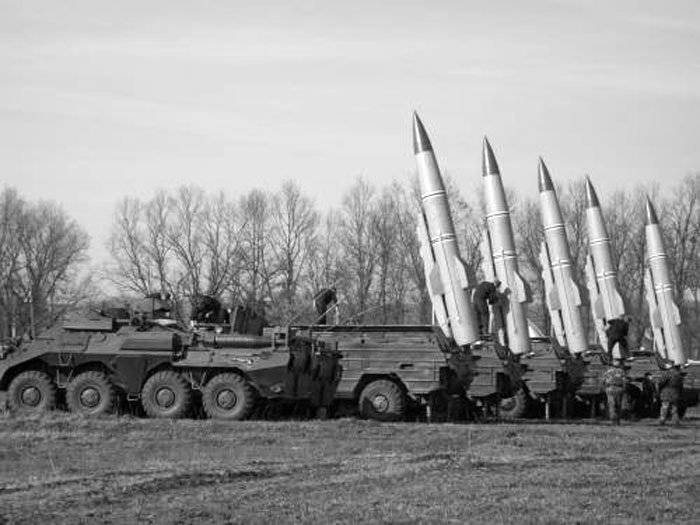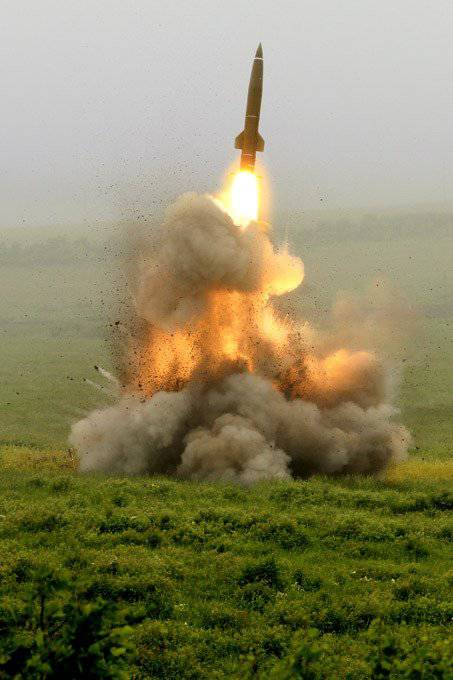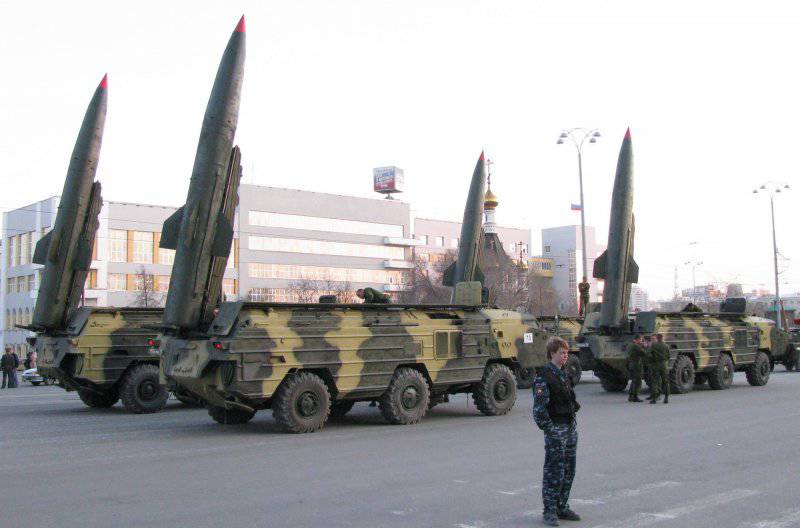The whole essence of the title: rocket complex "Tochka-U"
Factory tests of the first version of “Point” began in the 1971 year, and two years later they launched mass production. But for a number of reasons, the “Point” was adopted only in the 1976. The missile launch range was 70 kilometers, and the deviation from the target was no more than 250 meters. Immediately after the release of "Point" to the tests in the Central Research Institute AG began work on a new electronics to modify the rocket called "Point-R". This rocket was supposed to have a passive radar homing head, but in the end it was decided to give the anti-radar niche to lighter missiles. Since 1989, the upgraded Tochka-U complex, which included new 9М79М and 9М79-1 missiles, has gone to the troops. In addition, they replaced the new and part of the ground equipment.
As a result of the replacement of the missile, the maximum target range increased to 120 km, and the minimum remained at the level of 15. Accuracy has also significantly improved - the deviation now does not exceed one hundred meters, although generally it has much smaller values. Thus, at the international exhibition IDEX-93, five Point-U missiles did not miss more than 50 meters. The minimum error was within 5-7 meters. Such high accuracy was achieved by using new guidance equipment available in the 9М79М and 9М79-1 missiles themselves. In contrast to previous tactical missiles, the Point system of all modifications ensures course correction throughout the flight, up to and including a target. The inertial automatic control of the rocket consists of a command-gyroscopic device, a discrete analog transmitter, automatic hydraulic drive and a set of sensors. In the first few seconds of the flight, until a certain speed is reached, the rocket is controlled using gas rudders, and then throughout the flight the course is adjusted using aerodynamic rudders of the design. The 9М79 engine runs on solid fuel and has only one mode. The cylindrical block of fuel with longitudinal grooves is started with the help of an igniter (briquettes of special composition and black powder). Combustion of the fuel mixture takes place before the missile encounters with the goal - “The Point” is the first Soviet tactical complex, where the engine is not shut down before the last flight stage.

In the plumage of a rocket, in addition to the four reshear rudders, are four trapezoidal wings. In the stowed position, all protruding parts are folded, turning relative to the rocket body. For 9М79М and 9М79-1 missiles, several types of warheads for various purposes have been developed:
- 9Н39 - nuclear warhead with an AA-60 charge of 10-100 power in kilotons of TNT;
- 9H64 - nuclear warhead with a charge of AA-86. Power up to 100 CT.
- 9H123F - high-explosive fragmentation warhead with 162,5 kg of explosive and 14500 ready fragments. In an explosion at an altitude of 20 meters, fragments hit objects in an area up to 3 ha;
- 9H123K - cluster warhead. Contains 50 frag elements with 1,5 kg of explosive and 316 shrapnel in each. At a height of 2250 meters above the surface, the automatics opens the cassette, as a result of which up to seven hectares are sown with fragments;
- 9Н123Г and 9Н123Г2-1 - combat units equipped with 65 elements with toxic substances. In total, 60 and 50 kg of substances fit in the CU, respectively. There is information on the development of these head parts, but there is no data on production or applications. Most likely, they did not begin to bring and run in the series.
It is also sometimes claimed that there are campaign and anti-radar head units, but there is no official data on them. The head part is attached to the rocket with six bolts. A letter corresponding to the type of warhead is added to the alphanumeric rocket index - 9М79-1Ф for high-explosive fragmentation, 9М79-1К for cassette, etc. The assembled missile with a non-nuclear warhead can be stored for up to 10 years. According to calculations, to defeat an RSZO or tactical missile battery, it is required to expend 2 rockets with a cassette warhead or four high-explosive rockets. To defeat an artillery battery requires half the consumption of ammunition. For sowing splinters and destroying manpower and light equipment on an area up to 100 ha, four cluster or eight high-explosive rockets must go.
 The rocket is launched from the 9P129М-1 machine, made on the BAZ-5921 chassis. The equipment of the launcher allows you to independently make all the necessary preparations for the launch and calculations associated with the aiming and the flight mission of the rocket. Start can be made from virtually any site of sufficient size, and preparation for it takes about 16 minutes in the case of firing from the march or 2 minutes from the ready state No. 1. The only requirements for the placement of the launcher relate to the state of the surface of the platform and the placement of the machine - the target should be in the sector ± 15 ° from its longitudinal axis. It takes no more than one and a half to two minutes to collapse the installation and leave the launch site. An interesting fact is that the rocket (in the stowed position is located in the load compartment of the launch vehicle on the lifting rail) is transferred to the starting angle of elevation 78 ° only 15 seconds before launch. This helps to impede the work of reconnaissance of the enemy. The crew of the launch vehicle consists of four people: the head of the crew, the driver-mechanic, the senior operator (he is the deputy head of the crew) and the operator.
The rocket is launched from the 9P129М-1 machine, made on the BAZ-5921 chassis. The equipment of the launcher allows you to independently make all the necessary preparations for the launch and calculations associated with the aiming and the flight mission of the rocket. Start can be made from virtually any site of sufficient size, and preparation for it takes about 16 minutes in the case of firing from the march or 2 minutes from the ready state No. 1. The only requirements for the placement of the launcher relate to the state of the surface of the platform and the placement of the machine - the target should be in the sector ± 15 ° from its longitudinal axis. It takes no more than one and a half to two minutes to collapse the installation and leave the launch site. An interesting fact is that the rocket (in the stowed position is located in the load compartment of the launch vehicle on the lifting rail) is transferred to the starting angle of elevation 78 ° only 15 seconds before launch. This helps to impede the work of reconnaissance of the enemy. The crew of the launch vehicle consists of four people: the head of the crew, the driver-mechanic, the senior operator (he is the deputy head of the crew) and the operator.The missiles are placed on the launcher using the 9Т218-1 transport-charging vehicle (made on the BAZ-5922 chassis). In her sealed cargo compartment can accommodate two missiles with docked head pieces. There is a crane and a number of related equipment for loading the missiles into the launch vehicle on the transport-charging vehicle. Loading operations can be carried out on any, including an unprepared site, on which a launching and charging vehicle can side by side. Overloading one rocket takes about twenty minutes.
The complex also includes the 9Т238 transport vehicle, which differs from the transport-charging vehicle only by the absence of loading equipment. The 9Т238 can simultaneously carry up to two missiles or four warheads in transport containers.
For more than twenty years of its service, "Tochka-U" had a chance to participate in hostilities only a few times. General G. Troshev in his book "The Chechen Break" wrote that, thanks to the use of this missile complex, it was possible to prevent the departure of terrorists from the village of Komsomolskoye. The militants tried to pass between the positions of the army and the soldiers of the Ministry of Internal Affairs, but the rocket men covered them with an accurate salvo. At the same time, the federal forces, despite short distances, did not suffer losses from the “Point” strike. Also in the press were information about the use of "points" in the warehouses and camps of terrorists. During the war in South Ossetia in August 2008 of the year, information appeared about the use of “Points-U” by the Russian side.
Despite its already considerable age, the tactical missile system "Tochka-U" is not yet planned to be removed from service. There is a version that this will happen not earlier than the time when there will be a sufficient number of operational-tactical "Iskander" in the Russian army.

Information